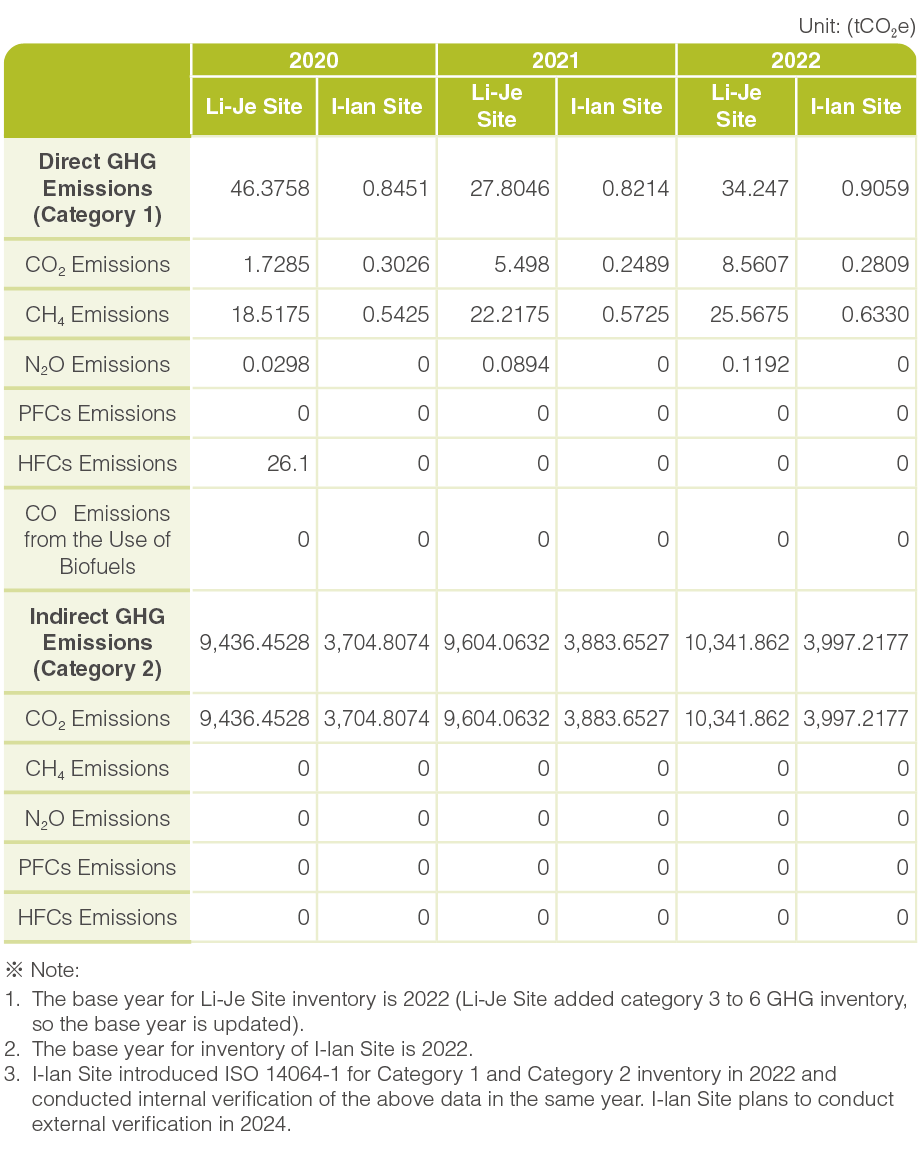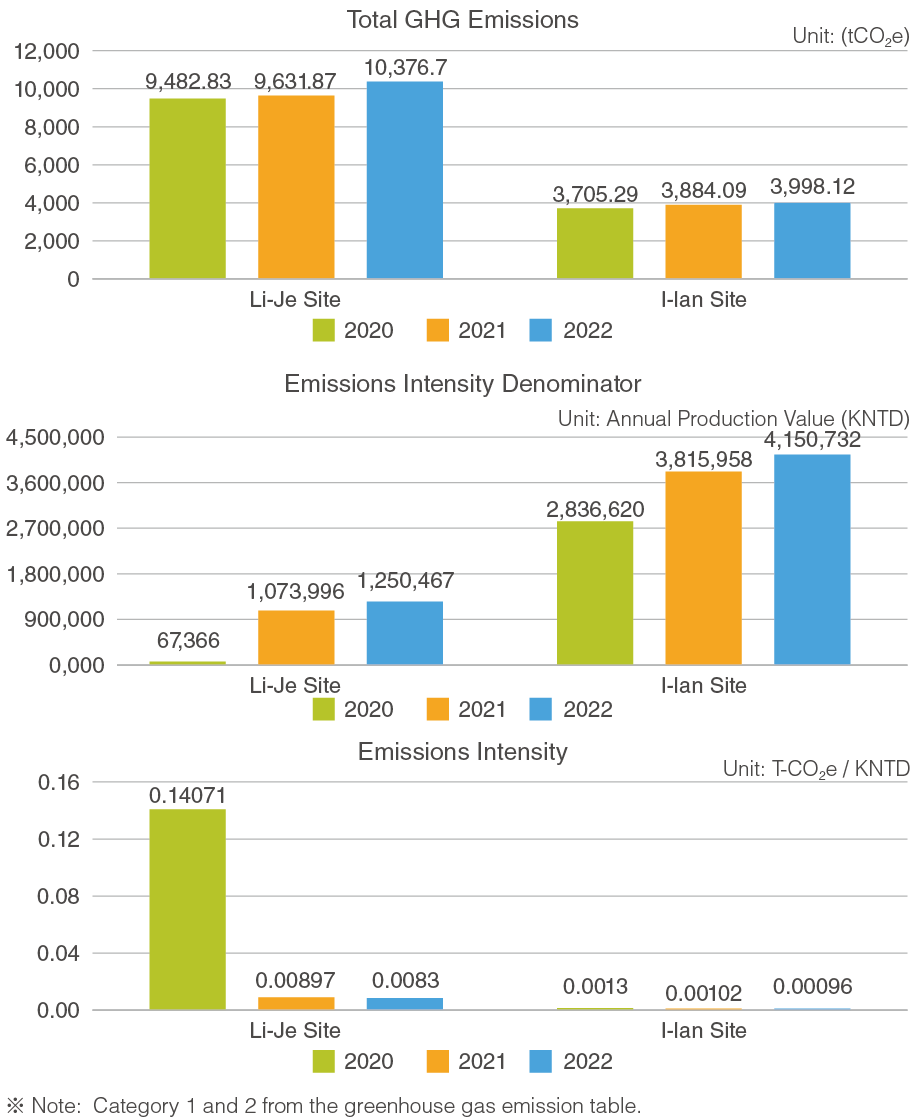Sustainability
Sustainability
GHG Management
TSC plays a vital role in the semiconductor manufacturing chain and also endorses the concept of “Extended Producer Responsibility”. The Company is committed to producing and designing environmentally friendly products, reducing product packaging, and researching environmentally friendly materials that are easily biodegradable. To implement various environmentally friendly projects more efficiently, TSC’s Corporate Sustainability Office has set up an “Environmental and Energy Management Team” functional group to be responsible for annual carbon reduction goals and Implement various greenhouse gas reduction plans, promote renewable energy layout, etc., from the system to reduce greenhouse gas emissions.
Greenhouse Gas Inventory
TSC has implemented a greenhouse gas inventory mechanism in accordance with ISO 14064-1. The Li-Je Site has been conducting inventories for scope 1 and 2 (categories 1 and 2) since 2014, and expanded to include scope 3 (categories 3 to 6) in 2022. The I-lan Site began conducting inventories for categories 1 and 2 in 2022. TSC plans to further expand its inventory scope in 2024 to include TSC headquarters and overseas business locations, demonstrating its ongoing commitment to Climate Action. In 2022, TSC saw a slight increase in categories 1 and 2 compared to 2021, attributed to increased production capacity. However, the intensity of carbon emissions per unit has been reduced for three consecutive years. TSC will continue to implement energy-saving and carbon reduction initiatives through various programs in the future.
In 2022, the primary carbon emissions at TSC’s two sites are attributed to outsourced electricity in category 2. The direct greenhouse gas emissions (category 1) at TSC’s I-lan Site amount to 0.9059 tCO₂e, while the emissions from outsourced electricity (category 2) total 3997.2177 tCO₂e, accounting for 99.98% of the site’s total emissions. Similarly, at the Li-Je Site, the main source of greenhouse gas emissions is outsourced electricity in category 2, which amounts to 10341.862 tCO₂e. This is followed by other indirect emissions (categories 3 to 6) totaling 4672.2161 tCO₂e, and finally, direct greenhouse gas emissions (category 1) of 34.247 t-CO₂e.
Greenhouse Gas Emissions at the I-lan and Li-Je Sites in 2022

Greenhouse Gas Emissions Intensity

Other Indirect GHG Emissions (Categories 3 to 6)
Since 2022, TSC’s Li-Je Site has conducted an inventory of other indirect GHG emissions. In 2022, the Li-Je Site’s Category 3 and Category 4 were the largest suppliers of raw material intake – AUEEC and Taiwan Maxwave materials transportation emissions, as well as for upstream fuel-energy related activities and operational waste treatment, the results were 4672.2161tCO₂e.
| Site | Category | Emission Source | GHG Type | Emissions(tCO2e) | Total(tCO2e) |
| Li-Je Site | Category 3 | Transport Emissions | CO2 | 2675.7714 | 4672.2161 |
| Category 4 | Product Emissions from Organization Use | CO2 | 1996.4447 |
Future Carbon Reduction Program
The carbon reduction programs for both short and medium-term are divided into five categories: equipment replacement, energy-saving projects, clean energy utilization, building management systems, and digital management systems. TSC optimizes energy efficiency through a “source-first” reduction strategy, along with optimizing process conditions and replacing inefficient processing equipment. This helps to reduce both direct and indirect greenhouse gas emissions in our operations and processes.
| Strategic Policy | 2023 | 2024-2025 |
| Replace the Old with the New | 1. I-lan Site has implemented an improvement plan for the ice water pump and cooling water pump. As part of this plan, frequency converters have been installed for the existing equipment. It is estimated that this installation will result in an annual reduction of electricity consumption by 4.9% by the end of the year. 2. Li-Je Site’s performance improvement plan involves incorporating a high-performance magnetic suspension chiller, while retaining the old machines as backups. This strategy results in a 45% reduction in power consumption compared to conventional chillers. | Since 2023, each site has proposed an improvement plan for the following year, including lighting improvement, energy-saving air conditioning, and other initiatives. |
| Energy Saving Project | 1. Apply carbon reduction to energy consumption equipment of each site, employ energy-saving chiller. 2. Replace old equipment with new to improve energy efficiency. | Conduct regular examinations of facilities to continuously improve carbon reduction, |
| Using Clean Energy | Plans for using renewable energy sources in sites are based on the principles of energy conservation, creation, and storage. 1. I-lan Site has formulated a solar panel assessment plan to achieve the goal of self-sustainability. 2. Solar and energy storage programs assessed by each site. 3. Outsourced green electricity programs assessed by each site. | 1. Roof solar panel installation program 2. Using Green Electricity |
| Establishment of Management System | 1. Implement or update ISO 50001 energy management system at each site 2. ISO 14064-1:2018 GHG Inventory (categories 1 and 2 with partial categories 3 to 6) | ISO management system of each site is continuously updated and passed third-party certification. 1. Conduct internal inventory and audit annually, and obtain accreditation from a third-party certification authority regularly. 2. Assess and introduce ISO 14067 product carbon footprint, and apply it to the main product line first. |
| Introducing Digital Management System | Assess smart carbon management programs | 1. Intelligent monitoring and management of energy resources 2.Collect real-time data to perform analysis and prediction |



